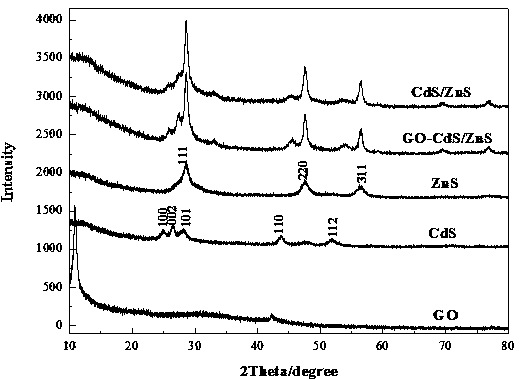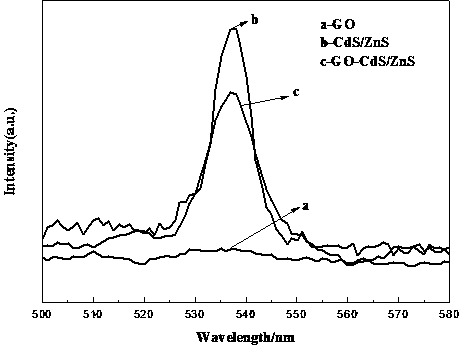Method for preparing nanocomposite photocatalyst and application of nanocomposite photocatalyst
A nanocomposite material and photocatalyst technology, which is applied in the field of hydrothermal synthesis of CdS/ZnS nanocomposite supported graphene oxide photocatalyst, can solve problems such as limitations, and achieve the advantages of simple operation, high-efficiency treatment technology, and green environmental protection treatment technology Effect
- Summary
- Abstract
- Description
- Claims
- Application Information
AI Technical Summary
Problems solved by technology
Method used
Image
Examples
Embodiment 1
[0033] Preparation of graphene oxide:
[0034] Add 1g of natural graphite and 2.5g of sodium nitrate into a three-necked flask filled with 30g of concentrated sulfuric acid, place in an ice bath, slowly add 4g of potassium permanganate while stirring, and keep at 15°C for 2h. Then heated in a water bath at 35 °C and stirred for 30 min. The solution turned dark green and bubbles were formed at the same time. Add 40 ml of distilled water to the solution and set the heating temperature of the water bath to 98 °C for 40 min. Add 140ml of distilled water to terminate the reaction, then add 10g, 30% hydrogen peroxide aqueous solution, the solution turns golden yellow, let it stand, pour off the supernatant, and use concentrated hydrochloric acid and water to mix the mixture at a volume ratio of 1:10 Washing, stirring for 30 minutes, standing still, pouring off the supernatant, washing with distilled water until neutral, and drying in a vacuum oven to obtain graphene oxide.
Embodiment 2
[0036] (1) Take by weighing 0.0026g of graphene oxide obtained in Example 1 and add deionized water to ultrasonic vibration until completely dissolved to form a homogeneous solution; add 0.0416g cadmium chloride and 0.0248g zinc chloride, stir until completely dissolved, Add 0.1756g of L-cysteine and stir until it is completely dissolved. After fully stirring, adjust the pH of the solution to 7 with 1mol / L sodium hydroxide solution, then add 0.0876g of sodium sulfide to the above solution, and stir for 15 minutes with nitrogen gas , poured into a 50mL autoclave at 180 o C for 1 h, take out and cool naturally, centrifuge the cooled solution, wash and put it in a vacuum drying oven at 50°C for 6 h, dry it and grind it to obtain a CdS / ZnS nanocomposite supported graphene oxide photocatalyst.
[0037] (2) Take the sample in (1) and carry out the photocatalytic degradation test in a 0.05g photochemical reaction apparatus. It is measured that the degradation rate of the photocatalys...
Embodiment 3
[0039] By the steps in Example 2, the difference is that (1) selects the amount of graphene oxide 0.0053g, wherein the quality of cadmium chloride, zinc chloride, L-cysteine, sodium sulfide is constant, after the reaction finishes Take it out and let it cool naturally, centrifuge the cooled solution, wash it and put it into a vacuum drying oven to dry and grind it to obtain a photocatalyst.
[0040] (2) Take 0.05 g of the sample in (1) and conduct photocatalytic degradation test in a photochemical reaction apparatus. It is measured that the degradation rate of the prepared photocatalyst to 10 mg / L tetracycline antibiotic reaches 82.06% within 60 min.
PUM
 Login to View More
Login to View More Abstract
Description
Claims
Application Information
 Login to View More
Login to View More - R&D
- Intellectual Property
- Life Sciences
- Materials
- Tech Scout
- Unparalleled Data Quality
- Higher Quality Content
- 60% Fewer Hallucinations
Browse by: Latest US Patents, China's latest patents, Technical Efficacy Thesaurus, Application Domain, Technology Topic, Popular Technical Reports.
© 2025 PatSnap. All rights reserved.Legal|Privacy policy|Modern Slavery Act Transparency Statement|Sitemap|About US| Contact US: help@patsnap.com



